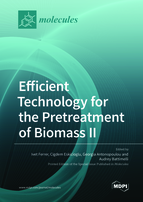Efficient Technology for the Pretreatment of Biomass II
A special issue of Molecules (ISSN 1420-3049). This special issue belongs to the section "Green Chemistry".
Deadline for manuscript submissions: closed (30 November 2019) | Viewed by 50128
Special Issue Editors
Interests: biodegradable waste; microalgae, sewage sludge, biogas; anaerobic digestion; co-digestion; biomass pretreatment; life cycle assessment (LCA); low-tech digesters
Special Issues, Collections and Topics in MDPI journals
Interests: sludge pretreatment; advanced anaerobic digestion; nutrient removal/recovery from wastewater; odor minimization; fate of micropollutants
Special Issues, Collections and Topics in MDPI journals
Interests: microbial fuel cells (MFCs); microbial electrolysis cells (MECs); biofuel production via microbial processes (anaerobic digestion, fermentative hydrogen production and bioethanol production)
Special Issues, Collections and Topics in MDPI journals
Interests: anaerobic digestion; physicochemical process; recalcitrant organic matter; digestate valorisation; fatty waste; sludge; manure; agricultural residues
Special Issue Information
Dear Colleagues,
Biomass can be used as feedstock for the production of biomaterials, chemicals, platform molecules, or biofuels. It is the most reliable alternative to reduce fossil fuel consumption and greenhouse gas emissions. Within the framework of the circular economy, resource recovery from organic waste, including sewage sludge, municipal solid-waste, biowaste, manure, and slaughterhouse waste, is particularly useful, as it helps save resources while reducing environmental pollution. In contrast to energy crops, lignocellulosic biomass and algae do not compete for food production; hence, they represent an important source of biomass for bioenergy and bioproducts. However, biomass may require a pretreatment step in order to enhance its conversion into valuable products in terms of process yield and/or productivity. Furthermore, a pretreatment step may be mandatory for waste management (i.e., animal by-products).
Pretreatment technologies are applied upstream of various conversion processes of biomass into biofuels or biomaterials, including bioethanol, biohydrogen, biomethane, biomolecules, or bioproducts. Pretreatments may include mechanical, thermal, chemical, and biological techniques, which represent a crucial, cost-intensive step for the development of biorefineries. Thus, research is needed to help identify the most effective, economic, and environmentally friendly pretreatment options for each feedstock.
This Special Issue aims to gather research papers on recent developments of biomass pretreatments for bioproducts or biofuels production. Papers describing new insights on pretreatment mechanisms; the development of new, efficient pretreatment processes; and environmental, energy, or economic assessments and modeling of pretreatment processes are particularly expected. Review articles are also welcome.
Dr. Ivet Ferrer
Dr Cigdem Eskicioglu
Dr. Audrey Battimelli
Dr. Georgia Antonopoulou
Guest Editors
Manuscript Submission Information
Manuscripts should be submitted online at www.mdpi.com by registering and logging in to this website. Once you are registered, click here to go to the submission form. Manuscripts can be submitted until the deadline. All submissions that pass pre-check are peer-reviewed. Accepted papers will be published continuously in the journal (as soon as accepted) and will be listed together on the special issue website. Research articles, review articles as well as short communications are invited. For planned papers, a title and short abstract (about 100 words) can be sent to the Editorial Office for announcement on this website.
Submitted manuscripts should not have been published previously, nor be under consideration for publication elsewhere (except conference proceedings papers). All manuscripts are thoroughly refereed through a single-blind peer-review process. A guide for authors and other relevant information for submission of manuscripts is available on the Instructions for Authors page. Molecules is an international peer-reviewed open access semimonthly journal published by MDPI.
Please visit the Instructions for Authors page before submitting a manuscript. The Article Processing Charge (APC) for publication in this open access journal is 2700 CHF (Swiss Francs). Submitted papers should be well formatted and use good English. Authors may use MDPI's English editing service prior to publication or during author revisions.
Keywords
- new pretreatment technologies
- pretreatment mechanisms
- biomass fractionation for biorefinery
- pretreatment modelling
- environmental assessment
- energy assessment
- economic assessment
- life-cycle assessment









